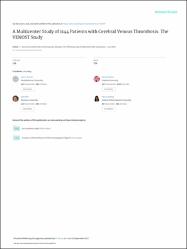A multicenter study of 1144 patients with cerebral venous thrombosis: the VENOST study

Göster/
Erişim
info:eu-repo/semantics/openAccessTarih
2017Yazar
Duman, TaşkınUludüz, Derya
Midi, İpek
Bektaş, Hesna
Kablan, Yüksel
Göksel, Başak K.
Milanlıoğlu, Aysel
Örken, Dilek Necioğlu
Aluçlu, Ufuk
Çolakoğlu, Sena
Tüfekçi, Ahmet
Bakar, Mustafa
Nazlıel, Bijen
Taşçılar, Nida
Göksan, Baki
Kozak, Hasan Hüseyin
Demir, Serkan
Mısırlı, Cemile Handan
Küçükoğlu, Hayriye
Çınar, Nilgün
Domaç, Füsun Mayda
Öztürk, Şerefnur
Yayla, Vildan
Karahan, Ali Yavuz
Afşar, Nazire
Göksu, Eylem Özaydın
Mengüllüoğlu, Necdet
Aytaç, Emrah
Yeşilot, Nilüfer
İnce, Birsen
Yalın, Özgür Osman
Oruç, Serdar
Demirci, Seden
Şenol, Mehmet Güney
Yılmaz, Arda
Gökçe, Mustafa
Küspeci, Zeynep Batur
Açıkgöz, Mustafa
Zeydan, Burcu
Özdağ, Murat
Yaman, Mehmet
Yürekli, Vedat Ali
Tekeli, Hakan
Genç, Hamit
Utku, Uygar
Tokuç, Firdevs Ezgi Uçan
Uzuner, Nevzat
Üst veri
Tüm öğe kaydını gösterKünye
Duman, T., Uluduz, D., Midi, I., Bektas, H., Kablan, Y., Goksel, B. K., Milanlioglu, A., Necioglu Orken, D., Aluclu, U., & VENOST Study Group (2017). A Multicenter Study of 1144 Patients with Cerebral Venous Thrombosis: The VENOST Study. Journal of stroke and cerebrovascular diseases : the official journal of National Stroke Association, 26(8), 1848–1857. https://doi.org/10.1016/j.jstrokecerebrovasdis.2017.04.020Özet
Background: Based on a number of small observational studies, cerebral venous sinus thrombosis has diverse clinical and imaging features, risk factors, and variable outcome. in a large, multicenter cerebral venous thrombosis (VENOST) study, we sought to more precisely characterize the clinical characteristics of Caucasian patients. Methods: All data for the VENOST study were collected between the years 2000 and 2015 from the clinical follow-up files. Clinical and radiological characteristics, risk factors, and outcomes were compared in terms of age and sex distribution. Results: Among 1144 patients 68% were women, and in older age group (>50 years) male patients were more prevalent (16.6% versus 27.8%). the most frequent symptoms were headache (89.4%) and visual field defects (28.9%) in men, and headache (86.1%) and epileptic seizures (26.8%) in women. Gynecological factors comprised the largest group in women, in particular puerperium (18.3%). Prothrombotic conditions (26.4%), mainly methylenetetrahydrofolate reductase mutation (6.3%) and Factor V Leiden mutation (5.1%), were the most common etiologies in both genders. 8.1% of patients had infection-associated and 5.2% had malignancy-related etiology that was significantly higher in men and older age group. Parenchymal involvement constitutively hemorrhagic infarcts, malignancy, and older age was associated with higher Rankin score. Epileptic seizures had no effect on prognosis. Conclusions: Clinical and radiological findings were consistent with previous larger studies but predisposing factors were different with a higher incidence of puerperium. Oral contraceptive use was not a prevalent risk factor in our cohort. Malignancy, older age, and hemorrhagic infarcts had worse outcome. (c) 2017 National Stroke Association. Published by Elsevier Inc. All rights reserved.
Kaynak
Journal of Stroke & Cerebrovascular DiseasesCilt
26Sayı
8Bağlantı
https://doi.org/10.1016/j.jstrokecerebrovasdis.2017.04.020https://hdl.handle.net/11436/2087

















